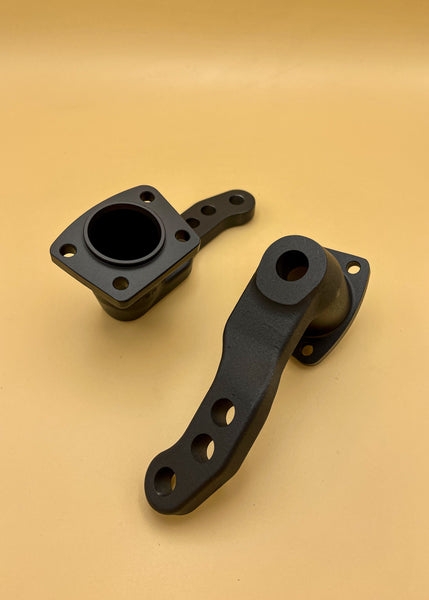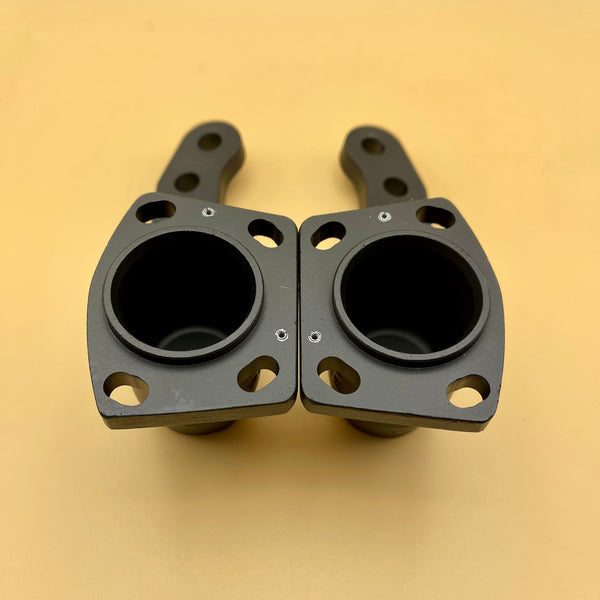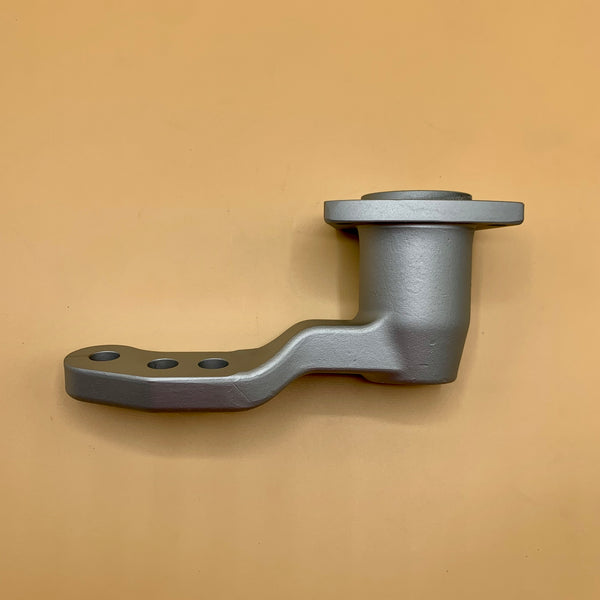240 Quick Steer Roll Correction V2.5
5-29 Update : This batch sold out, thank you everyone for your overwhelming support, we are working on the next batch and will post updates as we have them.
Key Features:
- One-piece cast 4140 Heat Treated Alloy Steel
- Utilizes factory ball joints and tie rods.
- Increased steering angle
- Fixes suspension geometry issues caused by lowering without adding excessive single shear loads
- Adjustable Steering Ratio
- CAD engineered and FEA validated design
- Geomet 720+ Coated
Kits include:
1 Left and 1 Right Roll Correction Spacer
8 Bolts and 8 Nordlok Washers
Ackermann adjustable kits include setup shims as well.
V2.5 Key Changes:
- Ackermann #5 is integrated as the default for 2nd and 3rd steering positions.
- Thicker Mounting Flange
- OEM Style Shoulder Mounting bolts
- Improved Ackermann shim setup
- Ackermann adjustable setups no longer have a stock steering ratio. This is only recommended for heavily modified setups, typically useful in drifting.
Details:
Quick Steer Roll Correction's purpose is to correct the front suspension geometry issues that result from lowering the car. Suspension systems have an "imaginary" point called a roll center (RC), the roll center is the point at which the car's suspension system pivots around. The location and height of the roll center are critical to how the car handles and accelerates out of corners. The height of the center of gravity (CG) of a vehicle and the height of the roll center have a relationship that can be described as a lever arm. The longer the lever arm, the more force the chassis will be subjected to while cornering. When the front of a 240 or any car is lowered the roll center moves below the ground, this increases the distance between the CG and RC; in effect, it increases the lever arm length and therefore increases the amount of body roll in the car. The front suspension has a separate roll center from the rear suspension. The rear suspension on a solid axle car has a geometry where the roll center height changes very little when the car's ride height is lowered. This leaves the rear RC high and the front RC low. If one draws a line between the two roll center heights, you would see there is an angle. The angle can be described as the roll axis inclination angle. The steeper this angle, the harder it is to put the power down on the corner exit. Many other things that roll center height dictates, but adjusting the front RC will affect how the back of the car works as well.
The Quick Steer Roll Correctors are unique because they have an integrated steering arm, the typical/generic approach has a been a long bolt installed with a spacer off the steering arm and a separate spacer for the ball joint bracket. This is far from ideal because you are putting a large cantilevered single shear load on the bolt that supports the tie rod / rod end, and this can lead to failure. The Quick Steer Roll Correctors have integrated steering arms that are compatible with the factory tie rod ends; this means no overloading in single shear. The new steering arm also presents an opportunity to modify the steering leverage ratio. The Quick Steer Roll Correctors have multiple steering leverage ratio options; The stock ratio is available, 20%, and 35% quicker ratio options. For comparison sake, the power steering has a 3.5 lock to lock ratio stock, 20% is 2.8, and 40% is 2.3. The manual rack has a 4.34 lock to lock ratio stock, 20% is ~3.5, and 35% is ~2.8. Now, these lock-to-lock comparisons are not technically correct because the lock of the steering rack is still the same, but it is a way to make a comparison that many are familiar with.
The Quick Steer Roll Correctors eliminate the need to use the factory tapered ball joint receiver. The bottom of the roll correction spacer is tapered to match the stock 240 balljoint. The holes on the steering arms are also tapered to match the stock 240 tie rod ends. If preferred to use a rod end and bolt, they can drill the tie rod holes to 14mm.
Finite Element Analysis (FEA) helps us to maximize the stiffness and strength of the part while minimizing the weight.
The flange is a very tight fit to the factory spindle, and the quality of this fitment ensures a good engagement with the machined large-diameter arc that is on the factory spindle. By making this tolerance tight, it helps to reduce torsional loads on the mounting bolts because the part can not twist without deforming the spindle.
This part has an affective 2.0" this is ideal for lowering the car between 1.5 and 2.0 inches. To maintain good geometry with additional lowering, we suggest you also purchased an additional spacer. The spacer drops the entire assembly. Spacers are available in 1" and .5" heights.
Thoughts from prototype dynamic testing @ auto-x:
The car has a good amount of grip; it feels more planted and stable than without the spacers. The acceleration out of corners due to the increase in the traction is impressive, especially considering the test car is running an open differential.
The steering ratio feels very nice, for 99% of driving, I don't have to shuffle my hands or cross over. Driving on a curvy highway at speed requires minimal movements to point the car. Another nice aspect is the reduced leverage ratio gives more feedback through the steering wheel, which with power steering, is very isolated. Driving through slaloms at a faster pace is more natural as less hand movement is required.
Ackermann Adjustment:
Q: Do I need it or want it?
A: With the introduction of Version 2, the need for additional Ackermann adjustment has been greatly reduced. We took the most popular Ackermann settings used with Version 1 for the middle and fastest hole and integrated them into the design. What this means is that for the majority of street and race cars, there will be no benefit for additional Ackermann adjustment. The only reason we still offer the Ackermann adjustment is for people with drift cars who will want to experiment and fine-tune their steering at high angles to match other car settings like specific tires.
Q: I bought the additional Ackermann adjustment and I am getting interference with the rotor in the higher steering positions?
A: With the additional Ackermann settings built-in, the adjustments allow the pickup points to move much further than the V1 units. Our Medium and Big Brake kits utilize a rotor that has a lower offset, this gives more space for the tie rod and steering arm to swing further out. If you want to utilize the more aggressive Ackermann shims, you will need to consider that type of solution.
Product fitment notes:
Due to the fact that this product LOWERS the pickup for the ball joint and tie rod, this naturally reduces clearance to wheels. This may cause some interference with small diameter wheels. Using a faster steering ratio adds additional clearance as does the use of a wheel spacer to move the wheel away from the ball joint and tie rod.
Another option if you wish to use a small diameter wheel without wheel spacers is using an Ackermann adjustable set to move the steering arm away from the wheel. This is not recommended, but it is an option.
This chart to help determine the compatibility of your wheels and offsets
| Wheel Spacing Requirement | Stock Steering Ratio | Middle Steering Ratio | Shortest Steering Ratio |
|
Factory 14" Steel Wheel 14x5.5J et20 |
25mm | 16.5mm | 0mm |
| 740 15" Alloy Wheel 15x6J et25 | 32mm | 0mm | 0mm |
Install Guide :




























